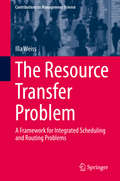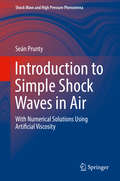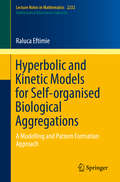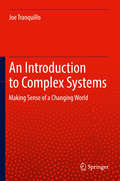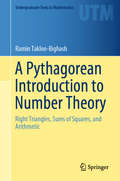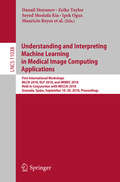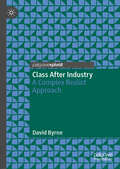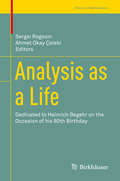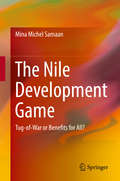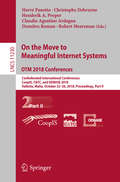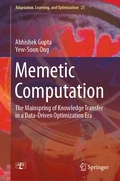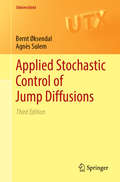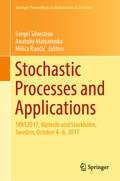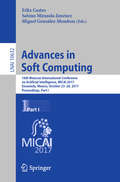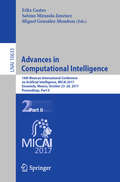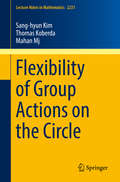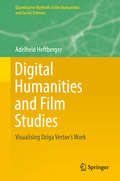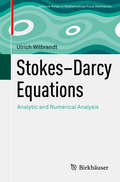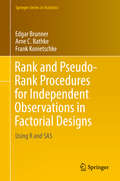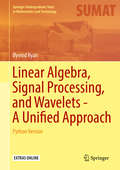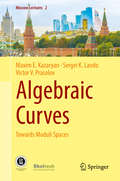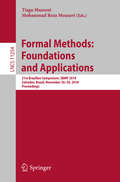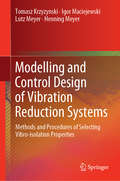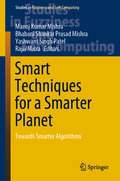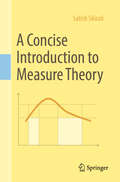- Table View
- List View
The Resource Transfer Problem: A Framework For Integrated Scheduling And Routing Problems (Contributions to Management Science)
by Illa WeissThe resource transfer problem (RTP) is a modeling and solution framework for integrated complex scheduling and rich vehicle routing problems. It allows the modeling of a wide variety of scheduling problems, vehicle routing problems, their combination with integrated problems, as well as various specific requirements and restrictions arising in practical scheduling and vehicle routing. Based on the unifying resource transfer problem framework, this book proposes a generic constraint propagation approach that exploits the specific structure of scheduling and routing problems.
Introduction to Simple Shock Waves in Air
by Seán PruntyThis book provides an elementary introduction to some one-dimensional fluid flow problems involving shock waves in air. The differential equations of fluid flow are approximated by finite difference equations and these in turn are numerically integrated in a stepwise manner. Artificial viscosity is introduced into the numerical calculations in order to deal with shocks. The presentation is restricted to the finite-difference approach to solve the coupled differential equations of fluid flow as distinct from finite-volume or finite-element methods. This text presents the results arising from the numerical solution using Mathcad programming. Both plane and spherical shock waves are discussed with particular emphasis on very strong explosive shocks in air. This text will appeal to students, researchers, and professionals in shock wave research and related fields. Students in particular will appreciate the benefits of numerical methods in fluid mechanics and the level of presentation.
Hyperbolic and Kinetic Models for Self-organised Biological Aggregations: A Modelling and Pattern Formation Approach (Lecture Notes in Mathematics #2232)
by Raluca EftimieThis book focuses on the spatio-temporal patterns generated by two classes of mathematical models (of hyperbolic and kinetic types) that have been increasingly used in the past several years to describe various biological and ecological communities. Here we combine an overview of various modelling approaches for collective behaviours displayed by individuals/cells/bacteria that interact locally and non-locally, with analytical and numerical mathematical techniques that can be used to investigate the spatio-temporal patterns produced by said individuals/cells/bacteria. Richly illustrated, the book offers a valuable guide for researchers new to the field, and is also suitable as a textbook for senior undergraduate or graduate students in mathematics or related disciplines.
An Introduction to Complex Systems: Making Sense of a Changing World
by Joe TranquilloThis book explores the interdisciplinary field of complex systems theory. By the end of the book, readers will be able to understand terminology that is used in complex systems and how they are related to one another; see the patterns of complex systems in practical examples; map current topics, in a variety of fields, to complexity theory; and be able to read more advanced literature in the field. The book begins with basic systems concepts and moves on to how these simple rules can lead to complex behavior. The author then introduces non-linear systems, followed by pattern formation, and networks and information flow in systems. Later chapters cover the thermodynamics of complex systems, dynamical patterns that arise in networks, and how game theory can serve as a framework for decision making. The text is interspersed with both philosophical and quantitative arguments, and each chapter ends with questions and prompts that help readers make more connections.
A Pythagorean Introduction to Number Theory: Right Triangles, Sums of Squares, and Arithmetic (Undergraduate Texts in Mathematics)
by Ramin Takloo-BighashRight triangles are at the heart of this textbook’s vibrant new approach to elementary number theory. Inspired by the familiar Pythagorean theorem, the author invites the reader to ask natural arithmetic questions about right triangles, then proceeds to develop the theory needed to respond. Throughout, students are encouraged to engage with the material by posing questions, working through exercises, using technology, and learning about the broader context in which ideas developed. Progressing from the fundamentals of number theory through to Gauss sums and quadratic reciprocity, the first part of this text presents an innovative first course in elementary number theory. The advanced topics that follow, such as counting lattice points and the four squares theorem, offer a variety of options for extension, or a higher-level course; the breadth and modularity of the later material is ideal for creating a senior capstone course. Numerous exercises are included throughout, many of which are designed for SageMath. By involving students in the active process of inquiry and investigation, this textbook imbues the foundations of number theory with insights into the lively mathematical process that continues to advance the field today. Experience writing proofs is the only formal prerequisite for the book, while a background in basic real analysis will enrich the reader’s appreciation of the final chapters.
Understanding and Interpreting Machine Learning in Medical Image Computing Applications: First International Workshops, Mlcn 2018, Dlf 2018, And Imimic 2018, Held In Conjunction With Miccai 2018, Granada, Spain, September 16-20, 2018, Proceedings (Lecture Notes in Computer Science #11038)
by Danail Stoyanov Zeike Taylor Seyed Mostafa Kia Ipek Oguz Mauricio Reyes Anne Martel Lena Maier-Hein Andre F. Marquand Edouard Duchesnay Tommy Löfstedt Bennett Landman M. Jorge Cardoso Carlos A. Silva Sergio Pereira Raphael MeierThis book constitutes the refereed joint proceedings of the First International Workshop on Machine Learning in Clinical Neuroimaging, MLCN 2018, the First International Workshop on Deep Learning Fails, DLF 2018, and the First International Workshop on Interpretability of Machine Intelligence in Medical Image Computing, iMIMIC 2018, held in conjunction with the 21st International Conference on Medical Imaging and Computer-Assisted Intervention, MICCAI 2018, in Granada, Spain, in September 2018. The 4 full MLCN papers, the 6 full DLF papers, and the 6 full iMIMIC papers included in this volume were carefully reviewed and selected. The MLCN contributions develop state-of-the-art machine learning methods such as spatio-temporal Gaussian process analysis, stochastic variational inference, and deep learning for applications in Alzheimer's disease diagnosis and multi-site neuroimaging data analysis; the DLF papers evaluate the strengths and weaknesses of DL and identify the main challenges in the current state of the art and future directions; the iMIMIC papers cover a large range of topics in the field of interpretability of machine learning in the context of medical image analysis.
Class After Industry: A Complex Realist Approach
by David ByrneThe transition to twenty-first century post-industrial capitalism from the ‘welfare’ industrial capitalism of the twentieth century, has affected the ways in which class is lived in terms of relational inequality and the factors that structure identity. Class After Industry takes a complex realist approach to the dynamics of individual lives, places, the social structure and analyses their significance in terms of class. A wide range of quantitative and qualitative studies are drawn on to explore how ‘life after industry’ shapes class, and the consequent potential for social change. The book will be of interest across the social sciences and beyond, to those concerned with how class forms might translate into political action.
Analysis as a Life: Dedicated to Heinrich Begehr on the Occasion of his 80th Birthday (Trends in Mathematics)
by Sergei Rogosin Ahmet Okay ÇelebiThis is a book comprising selected papers of colleagues and friends of Heinrich Begehr on the occasion of his 80th birthday. It aims at being a tribute to the excellent achievements of Heinrich Begehr in complex analysis and complex differential equations, and especially to his prominent role as one of the creators and long-time leader of the International Society for Analysis, its Applications and Computation (ISAAC).
The Nile Development Game: Tug-of-War or Benefits for All?
by Mina Michel SamaanThis book introduces an analytic framework constructed upon the iterated Prisoners' Dilemma game to model and analyze transboundary water interactions along the Nile River. It presents a thorough and in-depth analysis of the historical path through which conflict and cooperation have been generated among the Nile riparians over large-scale developmental schemes. This is done through modeling water interactions in the basin as an iterated Prisoners' Dilemma game and employing process-tracing method to compare four distinguishable rounds of the game: the colonial round, the Cold War round, the post-Cold War round, and the post-2011 round. The book examines the influences of the changing political contexts at the domestic, regional, and global levels on the game outcomes. This framework is initially applied on several cases of international rivers worldwide, while the rest of the book is devoted to the Nile case. The book's central argument is that the riparians' interests, capabilities, and beliefs are heterogeneous in varying degrees and that the changing multilevel political contexts influence the level of such heterogeneities among the riparians, which ultimately drive the equilibrium dynamics in the Nile game to generate different conflictive and cooperative outcomes over time. Although the book's main conclusion indicates that the absence of economic interdependence and regional integration will transfer the game into tug-of-war, which will impose harsh punishment on the basin communities and ecosystems on the long term, the final chapter lists a group of recommendations addressed to the riparian states and international donors, exploring the way for boosting cooperation and preventing conflicts in the basin. Presenting clear theoretical, methodological, and policy implications, this book is appropriate for students and scholars of international relations, hydrology, and development studies.
On the Move to Meaningful Internet Systems. OTM 2018 Conferences: Confederated International Conferences: CoopIS, C&TC, and ODBASE 2018, Valletta, Malta, October 22-26, 2018, Proceedings, Part II (Lecture Notes in Computer Science #11230)
by Hervé Panetto Christophe Debruyne Henderik A. Proper Claudio Agostino Ardagna Dumitru Roman Robert MeersmanThis double volumes LNCS 11229-11230 constitutes the refereed proceedings of the Confederated International Conferences: Cooperative Information Systems, CoopIS 2018, Ontologies, Databases, and Applications of Semantics, ODBASE 2018, and Cloud and Trusted Computing, C&TC, held as part of OTM 2018 in October 2018 in Valletta, Malta. The 64 full papers presented together with 22 short papers were carefully reviewed and selected from 173 submissions. The OTM program every year covers data and Web semantics, distributed objects, Web services, databases, informationsystems, enterprise workflow and collaboration, ubiquity, interoperability, mobility, grid and high-performance computing.
Memetic Computation: The Mainspring Of Knowledge Transfer In The Data-driven Optimization Era (Adaptation, Learning, and Optimization #21)
by Abhishek Gupta Yew-Soon OngThis book bridges the widening gap between two crucial constituents of computational intelligence: the rapidly advancing technologies of machine learning in the digital information age, and the relatively slow-moving field of general-purpose search and optimization algorithms. With this in mind, the book serves to offer a data-driven view of optimization, through the framework of memetic computation (MC). The authors provide a summary of the complete timeline of research activities in MC – beginning with the initiation of memes as local search heuristics hybridized with evolutionary algorithms, to their modern interpretation as computationally encoded building blocks of problem-solving knowledge that can be learned from one task and adaptively transmitted to another. In the light of recent research advances, the authors emphasize the further development of MC as a simultaneous problem learning and optimization paradigm with the potential to showcase human-like problem-solving prowess; that is, by equipping optimization engines to acquire increasing levels of intelligence over time through embedded memes learned independently or via interactions. In other words, the adaptive utilization of available knowledge memes makes it possible for optimization engines to tailor custom search behaviors on the fly – thereby paving the way to general-purpose problem-solving ability (or artificial general intelligence). In this regard, the book explores some of the latest concepts from the optimization literature, including, the sequential transfer of knowledge across problems, multitasking, and large-scale (high dimensional) search, systematically discussing associated algorithmic developments that align with the general theme of memetics. The presented ideas are intended to be accessible to a wide audience of scientific researchers, engineers, students, and optimization practitioners who are familiar with the commonly used terminologies of evolutionary computation. A full appreciation of the mathematical formalizations and algorithmic contributions requires an elementary background in probability, statistics, and the concepts of machine learning. A prior knowledge of surrogate-assisted/Bayesian optimization techniques is useful, but not essential.
Applied Stochastic Control of Jump Diffusions (Universitext)
by Bernt Øksendal Agnès SulemHere is a rigorous introduction to the most important and useful solution methods of various types of stochastic control problems for jump diffusions and its applications. Discussion includes the dynamic programming method and the maximum principle method, and their relationship. The text emphasises real-world applications, primarily in finance. Results are illustrated by examples, with end-of-chapter exercises including complete solutions. The 2nd edition adds a chapter on optimal control of stochastic partial differential equations driven by Lévy processes, and a new section on optimal stopping with delayed information. Basic knowledge of stochastic analysis, measure theory and partial differential equations is assumed.
Stochastic Processes and Applications: SPAS2017, Västerås and Stockholm, Sweden, October 4-6, 2017 (Springer Proceedings in Mathematics & Statistics #271)
by Sergei Silvestrov Anatoliy Malyarenko Milica RančićThis book highlights the latest advances in stochastic processes, probability theory, mathematical statistics, engineering mathematics and algebraic structures, focusing on mathematical models, structures, concepts, problems and computational methods and algorithms important in modern technology, engineering and natural sciences applications.It comprises selected, high-quality, refereed contributions from various large research communities in modern stochastic processes, algebraic structures and their interplay and applications. The chapters cover both theory and applications, illustrated by numerous figures, schemes, algorithms, tables and research results to help readers understand the material and develop new mathematical methods, concepts and computing applications in the future. Presenting new methods and results, reviews of cutting-edge research, and open problems and directions for future research, the book serves as a source of inspiration for a broad spectrum of researchers and research students in probability theory and mathematical statistics, applied algebraic structures, applied mathematics and other areas of mathematics and applications of mathematics.The book is based on selected contributions presented at the International Conference on “Stochastic Processes and Algebraic Structures – From Theory Towards Applications” (SPAS2017) to mark Professor Dmitrii Silvestrov’s 70th birthday and his 50 years of fruitful service to mathematics, education and international cooperation, which was held at Mälardalen University in Västerås and Stockholm University, Sweden, in October 2017.
Advances in Soft Computing: 16th Mexican International Conference on Artificial Intelligence, MICAI 2017, Enseneda, Mexico, October 23-28, 2017, Proceedings, Part I (Lecture Notes in Computer Science #10632)
by Félix Castro Sabino Miranda-Jiménez Miguel González-MendozaThe two-volume set LNAI 10632 and 10633 constitutes the proceedings of the 16th Mexican International Conference on Artificial Intelligence, MICAI 2017, held in Enseneda, Mexico, in October 2017. The total of 60 papers presented in these two volumes was carefully reviewed and selected from 203 submissions. The contributions were organized in the following topical sections: Part I: neural networks; evolutionary algorithms and optimization; hybrid intelligent systems and fuzzy logic; and machine learning and data mining. Part II: natural language processing and social networks; intelligent tutoring systems and educational applications; and image processing and pattern recognition.
Advances in Computational Intelligence: 16th Mexican International Conference on Artificial Intelligence, MICAI 2017, Enseneda, Mexico, October 23-28, 2017, Proceedings, Part II (Lecture Notes in Computer Science #10633)
by Félix Castro Sabino Miranda-Jiménez Miguel González-MendozaThe two-volume set LNAI 10632 and 10633 constitutes the proceedings of the 16th Mexican International Conference on Artificial Intelligence, MICAI 2017, held in Enseneda, Mexico, in October 2017. The total of 60 papers presented in these two volumes was carefully reviewed and selected from 203 submissions. The contributions were organized in the following topical sections: Part I: neural networks; evolutionary algorithms and optimization; hybrid intelligent systems and fuzzy logic; and machine learning and data mining. Part II: natural language processing and social networks; intelligent tutoring systems and educational applications; and image processing and pattern recognition.
Flexibility of Group Actions on the Circle (Lecture Notes in Mathematics #2231)
by Sang-Hyun Kim Thomas Koberda Mahan MjIn this partly expository work, a framework is developed for building exotic circle actions of certain classical groups. The authors give general combination theorems for indiscrete isometry groups of hyperbolic space which apply to Fuchsian and limit groups. An abundance of integer-valued subadditive defect-one quasimorphisms on these groups follow as a corollary. The main classes of groups considered are limit and Fuchsian groups. Limit groups are shown to admit large collections of faithful actions on the circle with disjoint rotation spectra. For Fuchsian groups, further flexibility results are proved and the existence of non-geometric actions of free and surface groups is established. An account is given of the extant notions of semi-conjugacy, showing they are equivalent. This book is suitable for experts interested in flexibility of representations, and for non-experts wanting an introduction to group representations into circle homeomorphism groups.
Digital Humanities and Film Studies: Visualising Dziga Vertov's Work (Quantitative Methods in the Humanities and Social Sciences)
by Adelheid HeftbergerThis book highlights the quantitative methods of data mining and information visualization and explores their use in relation to the films and writings of the Russian director, Dziga Vertov. The theoretical basis of the work harkens back to the time when a group of Russian artists and scholars, known as the “formalists,” developed new concepts of how art could be studied and measured. This book brings those ideas to the digital age. One of the central questions the book intends to address is, “How can hypothetical notions in film studies be supported or falsified using empirical data and statistical tools?” The first stage involves manual and computer-assisted annotation of the films, leading to the production of empirical data which is then used for statistical analysis but more importantly for the development of visualizations. Studies of this type furthermore shed light on the field of visual presentation of time-based processes; an area which has its origin in the Russian formalist sphere of the 1920s and which has recently gained new relevance due to technological advances and new possibilities for computer-assisted analysis of large and complex data sets. In order to reach a profound understanding of Vertov and his films, the manual or computer-assisted data analysis must be combined with film-historical knowledge and a study of primary sources. In addition, the status of the surviving film materials and the precise analysis of these materials combined with knowledge of historical film technology provide insight into archival policy and political culture in the Soviet Union in the 1920s and 30s.
Stokes–Darcy Equations: Analytic And Numerical Analysis (Advances in Mathematical Fluid Mechanics)
by Ulrich WilbrandtThis book offers a thorough guide starting from fundamental functional analysis leading to the coupling of Stokes and Darcy equations, including numerical analysis and scientific computing. Almost all intermediate results are given with complete, rigorous proofs, including theorems which can be rarely found in the literature such that this book serves well as a reference on the topic. Special care is taken to analyze the difficult cases of non-smooth interfaces which are not completely enclosed in one subdomain, i.e, intersect with the outer boundary. This can hardly be found in the literature. Additionally, known and new subdomain iterative methods are introduced, analyzed and applied to standard examples as well as one example motivated by a geoscientific setting.
Rank and Pseudo-Rank Procedures for Independent Observations in Factorial Designs: Using R and SAS (Springer Series in Statistics)
by Edgar Brunner Arne C. Bathke Frank KonietschkeThis book explains how to analyze independent data from factorial designs without having to make restrictive assumptions, such as normality of the data, or equal variances. The general approach also allows for ordinal and even dichotomous data. The underlying effect size is the nonparametric relative effect, which has a simple and intuitive probability interpretation. The data analysis is presented as comprehensively as possible, including appropriate descriptive statistics which follow a nonparametric paradigm, as well as corresponding inferential methods using hypothesis tests and confidence intervals based on pseudo-ranks. Offering clear explanations, an overview of the modern rank- and pseudo-rank-based inference methodology and numerous illustrations with real data examples, as well as the necessary R/SAS code to run the statistical analyses, this book is a valuable resource for statisticians and practitioners alike.
Linear Algebra, Signal Processing, and Wavelets - A Unified Approach: Python Version (Springer Undergraduate Texts in Mathematics and Technology)
by Øyvind RyanThis book offers a user friendly, hands-on, and systematic introduction to applied and computational harmonic analysis: to Fourier analysis, signal processing and wavelets; and to their interplay and applications. The approach is novel, and the book can be used in undergraduate courses, for example, following a first course in linear algebra, but is also suitable for use in graduate level courses. The book will benefit anyone with a basic background in linear algebra. It defines fundamental concepts in signal processing and wavelet theory, assuming only a familiarity with elementary linear algebra. No background in signal processing is needed. Additionally, the book demonstrates in detail why linear algebra is often the best way to go. Those with only a signal processing background are also introduced to the world of linear algebra, although a full course is recommended.The book comes in two versions: one based on MATLAB, and one on Python, demonstrating the feasibility and applications of both approaches. Most of the code is available interactively. The applications mainly involve sound and images. The book also includes a rich set of exercises, many of which are of a computational nature.
Algebraic Curves: Towards Moduli Spaces (Moscow Lectures #2)
by Maxim E. Kazaryan Sergei K. Lando Victor V. PrasolovThis book offers a concise yet thorough introduction to the notion of moduli spaces of complex algebraic curves. Over the last few decades, this notion has become central not only in algebraic geometry, but in mathematical physics, including string theory, as well. The book begins by studying individual smooth algebraic curves, including the most beautiful ones, before addressing families of curves. Studying families of algebraic curves often proves to be more efficient than studying individual curves: these families and their total spaces can still be smooth, even if there are singular curves among their members. A major discovery of the 20th century, attributed to P. Deligne and D. Mumford, was that curves with only mild singularities form smooth compact moduli spaces. An unexpected byproduct of this discovery was the realization that the analysis of more complex curve singularities is not a necessary step in understanding the geometry of the moduli spaces. The book does not use the sophisticated machinery of modern algebraic geometry, and most classical objects related to curves – such as Jacobian, space of holomorphic differentials, the Riemann-Roch theorem, and Weierstrass points – are treated at a basic level that does not require a profound command of algebraic geometry, but which is sufficient for extending them to vector bundles and other geometric objects associated to moduli spaces. Nevertheless, it offers clear information on the construction of the moduli spaces, and provides readers with tools for practical operations with this notion. Based on several lecture courses given by the authors at the Independent University of Moscow and Higher School of Economics, the book also includes a wealth of problems, making it suitable not only for individual research, but also as a textbook for undergraduate and graduate coursework
Formal Methods: 21st Brazilian Symposium, SBMF 2018, Salvador, Brazil, November 26–30, 2018, Proceedings (Lecture Notes in Computer Science #11254)
by Tiago Massoni Mohammad Reza MousaviThis book constitutes the refereed proceedings of the 21st Brazilian Symposium on Formal Methods, SBMF 2018, which took place in Salvador, Brazil, in November 2018.The 16 regular papers presented in this book were carefully reviewed and selected from 30 submissions. The papers are organized in topical sections such as: techniques and methodologies; specification and modeling languages; theoretical foundations; verification and validation; experience reports regarding teaching formal methods; and applications.Chapter “TeSSLa: Temporal Stream-Based Specification Language” is available open access under a Creative Commons Attribution 4.0 International License via link.springer.com.
Modelling and Control Design of Vibration Reduction Systems: Methods And Procedures Of Selecting Vibro-isolation Properties
by Tomasz Krzyzynski Igor Maciejewski Lutz Meyer Henning MeyerThis book describes the modelling and optimisation of vibration reduction systems in an integrated fashion using nonlinear equations of motion. It proposes an effective optimisation method for determining the basic characteristics of the non-linear visco-elastic elements used in passive vibration reduction systems. In the case of semi-active and active vibration isolators, a design process of the advanced control systems is proposed that makes possible to optimise the controller settings relatively to the selected vibro-isolation criteria. The approach developed here is subsequently tested by means of experimental investigations conducted on various sample vibration reduction systems: passive, semi-active and active. The book presents a biomechanical modelling approach that allows users to select the properties of vibro-isolation systems for different types of oscillation and different optimisation criteria – and can significantly reduce the harmful vibrations that can affect the human body in the process. Further, the book equips readers to evaluate the viscoelastic characteristics of passive systems and design control systems for semi-active and active systems. Modelling and Control Design of Vibration Reduction Systems offers a valuable guide for researchers and practitioners alike. It also provides students and academics with systematic information on the procedures to be followed in the design process for semi-active or active vibration reduction systems.
Smart Techniques for a Smarter Planet: Towards Smarter Algorithms (Studies in Fuzziness and Soft Computing #374)
by Manoj Kumar Mishra Bhabani Shankar Mishra Yashwant Singh Patel Rajiv MisraThis book is intended to provide a systematic overview of so-called smart techniques, such as nature-inspired algorithms, machine learning and metaheuristics. Despite their ubiquitous presence and widespread application to different scientific problems, such as searching, optimization and /or classification, a systematic study is missing in the current literature. Here, the editors collected a set of chapters on key topics, paying attention to provide an equal balance of theory and practice, and to outline similarities between the different techniques and applications. All in all, the book provides an unified view on the field on intelligent methods, with their current perspective and future challenges.
A Concise Introduction to Measure Theory
by Satish ShiraliThis undergraduate textbook offers a self-contained and concise introduction to measure theory and integration.The author takes an approach to integration based on the notion of distribution. This approach relies on deeper properties of the Riemann integral which may not be covered in standard undergraduate courses. It has certain advantages, notably simplifying the extension to "fuzzy" measures, which is one of the many topics covered in the book.This book will be accessible to undergraduate students who have completed a first course in the foundations of analysis. Containing numerous examples as well as fully solved exercises, it is exceptionally well suited for self-study or as a supplement to lecture courses.
